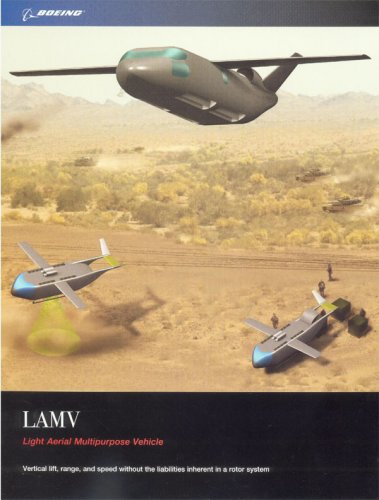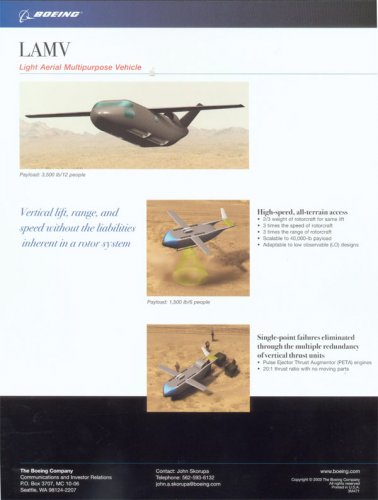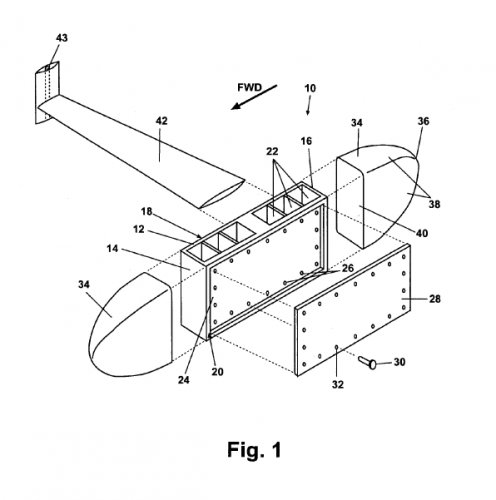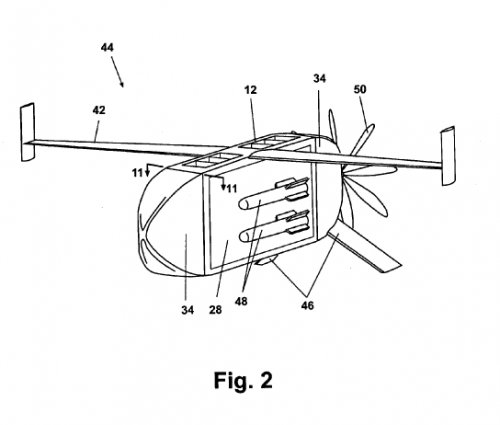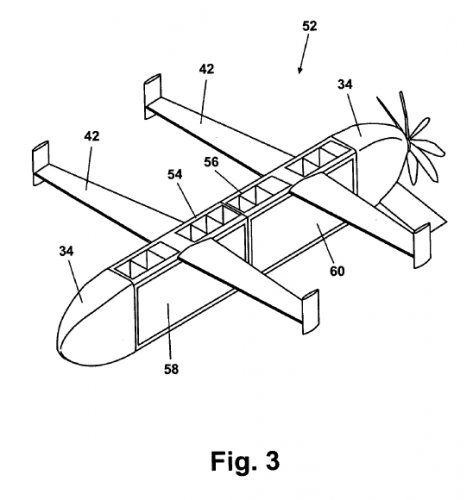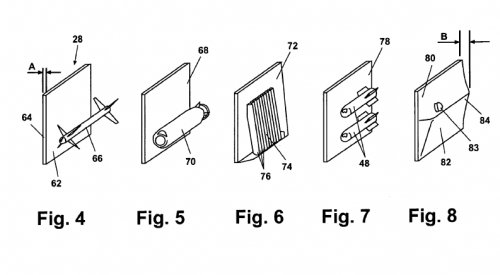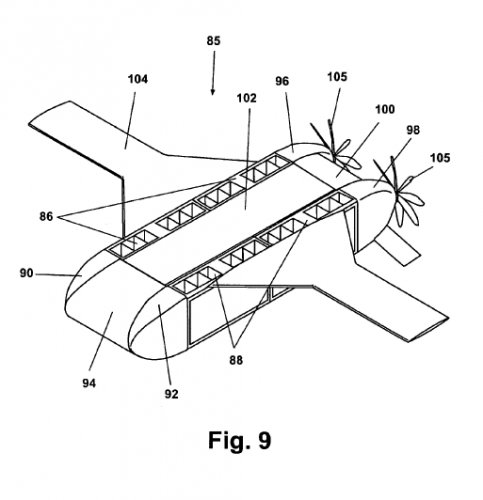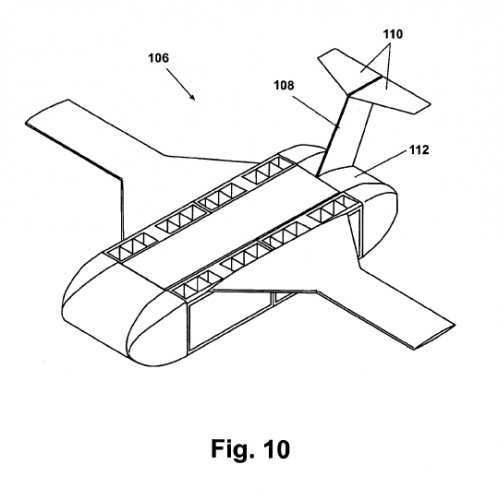You are using an out of date browser. It may not display this or other websites correctly.
You should upgrade or use an alternative browser.
You should upgrade or use an alternative browser.
Boeing Pulse-Ejector-Thrust-Augmentor (PETA) VTOL concepts
- Thread starter flateric
- Start date
Kim Margosein
ACCESS: Confidential
- Joined
- 9 February 2007
- Messages
- 101
- Reaction score
- 13
I love it. You see it in all the brochures from the C-119 to the present. What is the fixation with the USAF on landing fixed wing aircraft on the battlefield? There is some mortar operator just waiting put a $50million hole in the USAF's budget.
Kim M
Kim M
- Joined
- 18 October 2006
- Messages
- 4,211
- Reaction score
- 4,920
Other than the AFSOC bubba's who do heroic work supporting the Special Operations Forces the USAF does not land their aircraft on anything other than pristine runways, much to the irritation of their customers. As far as mortarmen having a great shot, long runways with well known locations are far more predictable than a spot in a field. Then I have been working on this sort of thing for the last several years.
The technology being worked by Boeing is a Pulse Injector type similar to that of the old German WW2 V-1.
The technology being worked by Boeing is a Pulse Injector type similar to that of the old German WW2 V-1.
Boeing video of its Pulse-Ejector-Thrust-Augmentor (PETA) VTOL concept.
http://youtu.be/ousW3b50M1Q
http://youtu.be/ousW3b50M1Q
Kryptid
ACCESS: Secret
- Joined
- 12 March 2009
- Messages
- 282
- Reaction score
- 52
What an unfortunate name.
I'm quite surprised by this. I figured that pulsejets were a dead technology, but I actually quite like this concept. I'm fond of the idea of pushing for simplicity when designing new engine technologies. Hard to get simpler than this.
I'm quite surprised by this. I figured that pulsejets were a dead technology, but I actually quite like this concept. I'm fond of the idea of pushing for simplicity when designing new engine technologies. Hard to get simpler than this.
S
sublight
Guest
They need to make a working prototype and then charge people to come see it. I would pay for front row seats. I foresee a need for serious ear protection though...
Nik
ACCESS: Top Secret
- Joined
- 15 July 2009
- Messages
- 1,269
- Reaction score
- 1,062
Well, I'm impressed Boeing have invoked the 'KISS' principle, but I can see several issues.
Okay, there are a lot of those things aboard, which implies they are individually of modest thrust. That's not a problem, they're mostly air-- In fact, having 'torpedo bulges' may be handy in a hot LZ.
Getting them all to light may be fun.
One possible gotcha: Back when I knew a bit about electronics, one known quirk of multiple 'similar' oscillators was that they'd self-synchronise. Any tiny fluctuation on the power / earth lines was sufficient to prompt entrainment. Here, fuel-line pulses, even hull vibrations should suffice. Having them fire asynchronously would be noisy, having them jack-hammer in unison would be horrible...
Remember NASA's panic when their 'new' expendable design showed such symptoms ? It can rip craft asunder...
I just hope the effect of air-flow across those tubes does not produce 'organ piping', as the result would be beyond deafening...
Okay, there are a lot of those things aboard, which implies they are individually of modest thrust. That's not a problem, they're mostly air-- In fact, having 'torpedo bulges' may be handy in a hot LZ.
Getting them all to light may be fun.
One possible gotcha: Back when I knew a bit about electronics, one known quirk of multiple 'similar' oscillators was that they'd self-synchronise. Any tiny fluctuation on the power / earth lines was sufficient to prompt entrainment. Here, fuel-line pulses, even hull vibrations should suffice. Having them fire asynchronously would be noisy, having them jack-hammer in unison would be horrible...
Remember NASA's panic when their 'new' expendable design showed such symptoms ? It can rip craft asunder...
I just hope the effect of air-flow across those tubes does not produce 'organ piping', as the result would be beyond deafening...
Avimimus
ACCESS: Top Secret
- Joined
- 15 December 2007
- Messages
- 2,426
- Reaction score
- 909
I noticed how they didn't mention anything about the fuel economy in hover... any idea how it would compare?
I suppose that lower efficiency might be compensated for by lighter weight (and greater economy) during the conventional cruise flight. I loved the manned "UAV" concept - very scifi...
I suppose that lower efficiency might be compensated for by lighter weight (and greater economy) during the conventional cruise flight. I loved the manned "UAV" concept - very scifi...
Fuel economy would suck.
Noise would be impressive.
The drag penalty would be impressive.
All reasons why Boeing (IIRC) abandoned this concept *years* ago. Boeing started flacking this idea around 2003, got patents around 2005, and I've not heard any more about it since.
Noise would be impressive.
The drag penalty would be impressive.
All reasons why Boeing (IIRC) abandoned this concept *years* ago. Boeing started flacking this idea around 2003, got patents around 2005, and I've not heard any more about it since.
- Joined
- 1 April 2006
- Messages
- 11,394
- Reaction score
- 10,296
http://www.google.com/patents/download/6824097_Vertical_takeoff_and_landing_air.pdf?id=RHkQAAAAEBAJ&output=pdf&sig=ACfU3U0otR0I5OXXGVQ6I6uMog5B3M1QwQ&source=gbs_overview_r&cad=0
http://www.google.com/patents/download/6926231_Vertical_takeoff_and_landing_air.pdf?id=9P0TAAAAEBAJ&output=pdf&sig=ACfU3U1UdBdeIgDZMVQeb96nAX6a_D73FA&source=gbs_overview_r&cad=0
http://www.google.com/patents/download/6976654_Vertical_takeoff_and_landing_air.pdf?id=0z8UAAAAEBAJ&output=pdf&sig=ACfU3U0FHn2Kanlf8wqwYluGDsaDqwpHZg&source=gbs_overview_r&cad=0
http://www.google.com/patents/download/6793174_Pulsejet_augmentor_powered_VTOL.pdf?id=aZ4QAAAAEBAJ&output=pdf&sig=ACfU3U3XznZiMFL6p-1zJeL-jKgsTUJTrg&source=gbs_overview_r&cad=0
http://www.google.com/patents/download/7581383_Acoustic_pulsejet_helmet.pdf?id=BF3KAAAAEBAJ&output=pdf&sig=ACfU3U1TgQrAxHBahPH1J7NQ2nztDVfVlQ
http://www.google.com/patents/download/7051510_Method_of_operating_a_pulsejet.pdf?id=BQt3AAAAEBAJ&output=pdf&sig=ACfU3U1C_5yLGNpoVkccL22OjD1R9unlZQ
http://www.google.com/patents/download/10_831_498_Pulsejet_ejector_thrust_augme.pdf?id=oSOSAAAAEBAJ&output=pdf&sig=ACfU3U1SJI1FBI1QcrZ2VE6WHXj3Yu3GRA&source=gbs_overview_r&cad=0
http://www.google.com/patents?id=xNOYAAAAEBAJ&printsec=frontcover&dq=11_190_264&hl=en&ei=pzIrTr_hO4nrOfL8hc4K&sa=X&oi=book_result&ct=result&resnum=1&ved=0CCgQ6AEwAA
http://www.google.com/patents/download/7427048_Linear_acoustic_pulsejet.pdf?id=k66tAAAAEBAJ&output=pdf&sig=ACfU3U25HNrlpH8Rhgd9304FPv_2te0FaA
http://www.google.com/patents/download/6926231_Vertical_takeoff_and_landing_air.pdf?id=9P0TAAAAEBAJ&output=pdf&sig=ACfU3U1UdBdeIgDZMVQeb96nAX6a_D73FA&source=gbs_overview_r&cad=0
http://www.google.com/patents/download/6976654_Vertical_takeoff_and_landing_air.pdf?id=0z8UAAAAEBAJ&output=pdf&sig=ACfU3U0FHn2Kanlf8wqwYluGDsaDqwpHZg&source=gbs_overview_r&cad=0
http://www.google.com/patents/download/6793174_Pulsejet_augmentor_powered_VTOL.pdf?id=aZ4QAAAAEBAJ&output=pdf&sig=ACfU3U3XznZiMFL6p-1zJeL-jKgsTUJTrg&source=gbs_overview_r&cad=0
http://www.google.com/patents/download/7581383_Acoustic_pulsejet_helmet.pdf?id=BF3KAAAAEBAJ&output=pdf&sig=ACfU3U1TgQrAxHBahPH1J7NQ2nztDVfVlQ
http://www.google.com/patents/download/7051510_Method_of_operating_a_pulsejet.pdf?id=BQt3AAAAEBAJ&output=pdf&sig=ACfU3U1C_5yLGNpoVkccL22OjD1R9unlZQ
http://www.google.com/patents/download/10_831_498_Pulsejet_ejector_thrust_augme.pdf?id=oSOSAAAAEBAJ&output=pdf&sig=ACfU3U1SJI1FBI1QcrZ2VE6WHXj3Yu3GRA&source=gbs_overview_r&cad=0
http://www.google.com/patents?id=xNOYAAAAEBAJ&printsec=frontcover&dq=11_190_264&hl=en&ei=pzIrTr_hO4nrOfL8hc4K&sa=X&oi=book_result&ct=result&resnum=1&ved=0CCgQ6AEwAA
http://www.google.com/patents/download/7427048_Linear_acoustic_pulsejet.pdf?id=k66tAAAAEBAJ&output=pdf&sig=ACfU3U25HNrlpH8Rhgd9304FPv_2te0FaA
- Joined
- 17 October 2006
- Messages
- 2,393
- Reaction score
- 1,197
The "FCS" mention is a clue to the video's age.
I wonder how the design trade would work out? OBB is right that the fuel economy would probably be non-stellar (except it's a detonating pulsejet, which is more efficient than deflagration) but the propulsion system weight would be much less than jets.
I wonder how the design trade would work out? OBB is right that the fuel economy would probably be non-stellar (except it's a detonating pulsejet, which is more efficient than deflagration) but the propulsion system weight would be much less than jets.
- Joined
- 31 May 2009
- Messages
- 1,154
- Reaction score
- 674
- Joined
- 9 October 2009
- Messages
- 21,973
- Reaction score
- 13,630
There is a possibility, only a possibility at the moment, mind!, that the new 'Yellow Jacket' drone from Boeing may be based on this: http://www.youtube.com/watch_popup?v=ousW3b50M1Q&vq=medium#t=324
May explain why this old concept is making the rounds again now (someone in PR flying a kite perhaps).
May explain why this old concept is making the rounds again now (someone in PR flying a kite perhaps).
- Joined
- 1 April 2006
- Messages
- 11,394
- Reaction score
- 10,296
Grey Havoc said:There is a possibility, only a possibility at the moment
me thinks, it's more prosaic, like this

http://www.schiebel.net/AcmsFile/579/0/550/2009-12-17_ASD_news.pdfSchiebel Industries AG of Austria and the Boeing Company [NYSE: BA] signed a teaming
agreement in August of 2009 to pursue marketing and support opportunities for Schiebel's
CAMCOPTER(r) S-100 in the United States and certain other markets.
In the fight against Improvised Explosive Devices (IEDs), Schiebel has been awarded a sub
contract by the U.S. technology company, CenTauri Solutions, to provide its CAMCOPTER(r) S-
100 UAV as the air vehicle for a counter IED project known as "Yellow Jacket". This is Schiebel's
first sale for use of its product by the U.S. DoD.
Date Posted: 30-Oct-2009 Schiebel breaks into US market with Camcopter deal Georg Mader CorrespondentViennaGareth Jennings Jane's Aviation Desk EditorLondonSchiebel Industries has secured its first sale to the US Department of Defense: a deal that follows efforts by the Austrian unmanned aerial vehicle specialist to break into the world'slargest defence market. It emerged on 26 October that the Schiebel Camcopter S-100 rotary-winged unmanned aerialvehicle (UAV) has been selected as the platform for the US Army's 'Yellow Jacket' counter-improvised explosive device (IED) project. Schiebel has been subcontracted by US company CenTauri Solutions to provide the vehicle tocarry its high-definition electro-optical sensor combined with an unintentionalelectromagnetic emissions detector to locate buried IEDs. Under the USD11 million contract the UAV company will support the US Department ofDefense's (DoD's) Joint Improvised Explosive Device Defeat Organization (JIEDDO) - ofwhich 'Yellow Jacket' is a part. 'Yellow Jacket' provides US and coalition patrols and convoys with technology to identify IED threats.Under the project, the US Air Force Research Laboratory (AFRL), in Rome, New York, has contracted CenTauri Solutions to examine the feasibility of using a vertical take-off andlanding (VTOL) UAVs to detect IEDs from the air. The accord comes after Boeing and Schiebel announced on 11 August that they had signed ateaming agreement relating to the latter's Camcopter S-100. The accord aimed to fill a gap in Boeing's range of UAVs and related capabilities. The agreement is not understood by Jane's to be directly related to the 26 October deal with CenTauri Solutions, but instead indicates Schiebel's strategic intentions. Copyright © IHS (Global) Limited, 2009
- Joined
- 1 April 2006
- Messages
- 11,394
- Reaction score
- 10,296
pometablava said:The links don`t work for me.
check now
- Joined
- 1 April 2006
- Messages
- 11,394
- Reaction score
- 10,296
Grey Havoc said:may be based on this
*thing* you liked so much is dubbed
with the same person - Richard P. Ouellette, PETA man - as inventor
http://www.google.com/patents/download/6926235_Runway_independent_omni_role_mod.pdf?id=-P0TAAAAEBAJ&output=pdf&sig=ACfU3U3Wc-EzpXjUk6-uXixMULbwuzdGZA&source=gbs_overview_r&cad=0
Attachments
circle-5 said:Unfinished LAMV models at the Boeing model shop. LAMV=Light Aerial Multipurpose Vehicle. LAMV came in 3 or 4 different sizes and configurations.
Looks more like the PETA concept described as the "Land Based Variant" in the video, rather than the LAMV, for the AMC-X and JVHL programs with a 50-to-60,000 lb. payload and a 540 n mile unrefueled radius.
- Joined
- 9 October 2009
- Messages
- 21,973
- Reaction score
- 13,630
All roads lead to ROME. 
On the other hand, the recent speculation on Yellow Jacket has leaning towards a rotorcraft. However the linking of the S-100 to the Yellow Jacket project seems be in relation to an earlier incarnation of Yellow Jacket, since the current Yellow Jacket project has seemingly expanded way beyond a simple Counter-IED program which only required a couple of primary sensors.
I don't think the S-100 has the capacity to carry the reported payload the current Yellow Jacket drone is supposed to be carrying (including, but apparently not limited to, a combination of MASINT, SIGINT and IMINT systems). Which is why I thought they might have gone with something based on our friend, which flateric has nailed down as the ROME drone. Not that that totally rules out the possibility that the Yellow Jacket drone is actually just a very heavy duty development of the S-100, although I find it unlikely. If it is a rotorcraft, it's likely to be a custom design, IMO.
On the other hand, the recent speculation on Yellow Jacket has leaning towards a rotorcraft. However the linking of the S-100 to the Yellow Jacket project seems be in relation to an earlier incarnation of Yellow Jacket, since the current Yellow Jacket project has seemingly expanded way beyond a simple Counter-IED program which only required a couple of primary sensors.
I don't think the S-100 has the capacity to carry the reported payload the current Yellow Jacket drone is supposed to be carrying (including, but apparently not limited to, a combination of MASINT, SIGINT and IMINT systems). Which is why I thought they might have gone with something based on our friend, which flateric has nailed down as the ROME drone. Not that that totally rules out the possibility that the Yellow Jacket drone is actually just a very heavy duty development of the S-100, although I find it unlikely. If it is a rotorcraft, it's likely to be a custom design, IMO.
- Joined
- 31 May 2009
- Messages
- 1,154
- Reaction score
- 674
Triton said:circle-5 said:Unfinished LAMV models at the Boeing model shop. LAMV=Light Aerial Multipurpose Vehicle. LAMV came in 3 or 4 different sizes and configurations.
Looks more like the PETA concept described as the "Land Based Variant" in the video, rather than the LAMV, for the AMC-X and JVHL programs with a 50-to-60,000 lb. payload and a 540 n mile unrefueled radius.
As was explained to me by the people at Boeing, PETA was the engine and LAMV was the airframe. PETA was to be used only with the LAMV, and the LAMV could be easily scaled, by changing the number of PETA engines.
The 3 or 4 LAMV variants shown in CGI and model form have the same basic configuration and were presented for the sole purpose of illustrating the flexibility of PETA clusters. This was a few years ago. It's quite possible the LAMV/PETA project was tailored to a specific program at some point, but it appears to have been abandoned about 18 months ago.
- Joined
- 25 June 2009
- Messages
- 14,753
- Reaction score
- 6,147
Grey Havoc said:On the other hand, the recent speculation on Yellow Jacket has leaning towards a rotorcraft.
Since a yellowjacket is a variety of wasp, it would make perfect sense indeed...
- Joined
- 9 October 2009
- Messages
- 21,973
- Reaction score
- 13,630
Stargazer2006 said:Grey Havoc said:On the other hand, the recent speculation on Yellow Jacket has leaning towards a rotorcraft.
Since a yellowjacket is a variety of wasp, it would make perfect sense indeed...
When I first heard it, the superhero reference popped into my head, which then brought to mind the idea it was a morphing drone of some kind. But then I remembered the PETA presentation, in particular the fact that designs using the architecture could be scaled up or down. That, combined somewhat illogically with the sound a PETA system makes, along with the fact that a PETA based drone might be able to comfortably carry a large payload, led to the idea that the UAV variant shown during the presentation might have something to do with the current Yellow Jacket drone.
I've taken a provisional liking to this idea, pending my actually reading the patents and stuff (... any CFD or empirical test data somewhere in the public domain, doesn't seem like the most challenging thing to prototype and/or test somehow?).
Tempering a pulse jet engine into producing more moderately oscillating thrust by very purposefully inducing a significant portion of the surrounding air mass might not be such a bad idea for smooth controlled operation. Simplicity and modularity are often virtues in themselves, especially if you don't have continuous ready access to huge maintenance resources. It's an innovative take on the old concept anyway, sort of a modern flying carpet even. Naming the setup an "augmentor" may be a bit inaccurate (... just as a bladeless Dyson fan doesn't really "multiply" air) since there's no "magic energy"added, just a conversion into a more specifically practical use (Pulse Propulsion Ascent/Descent System - "2PADS" - anyone? Boeing, hello?).
Mentioning of which, I don't really know whether the body shapes seen in the promotional video (... - "Can you make a short animation of this?" - "Sure." - "Good, have it ready for the presentation this afternoon." - " ... ohhh-kay?") are an optimal application ... how'bout embedding these into a flying wing airframe, those have big fat profiles anyway so this might not add as much to the front cross section? I can see the fuel economy (literally) sucking, yes, but short of an aerostat I'm not entirely sure if there's a vertical-cargo-capable aircraft out there which doesn't? This does seem a little bit more rational and less complex than the multitude of VTOL designs with dedicated lift turbines anyway.
... ohhh-kay?") are an optimal application ... how'bout embedding these into a flying wing airframe, those have big fat profiles anyway so this might not add as much to the front cross section? I can see the fuel economy (literally) sucking, yes, but short of an aerostat I'm not entirely sure if there's a vertical-cargo-capable aircraft out there which doesn't? This does seem a little bit more rational and less complex than the multitude of VTOL designs with dedicated lift turbines anyway.
But then again I kinda like those too anway. Irrational, I know.
Tempering a pulse jet engine into producing more moderately oscillating thrust by very purposefully inducing a significant portion of the surrounding air mass might not be such a bad idea for smooth controlled operation. Simplicity and modularity are often virtues in themselves, especially if you don't have continuous ready access to huge maintenance resources. It's an innovative take on the old concept anyway, sort of a modern flying carpet even. Naming the setup an "augmentor" may be a bit inaccurate (... just as a bladeless Dyson fan doesn't really "multiply" air) since there's no "magic energy"added, just a conversion into a more specifically practical use (Pulse Propulsion Ascent/Descent System - "2PADS" - anyone? Boeing, hello?).
Mentioning of which, I don't really know whether the body shapes seen in the promotional video (... - "Can you make a short animation of this?" - "Sure." - "Good, have it ready for the presentation this afternoon." - "
But then again I kinda like those too anway. Irrational, I know.
- Joined
- 18 October 2006
- Messages
- 4,211
- Reaction score
- 4,920
Having sat through a PETA brief that had variantions from utility helicopter size to C-17 size I can say that the audience was politely sceptical of a combat aircraft. Noise was the first question, a Navy rep asked how much heat that thing was going to put into the deck. An infantryman asked if he would have to contend with fire in the cabin if a bullet passed through a module into the cabin, followed by what happens when something like an RPG hits. He finished with how to do slingloads with it. Obviously looking at the tactical side of the possibilities.
To my knowledge Boeing has not done any work on PETA for several years.
To my knowledge Boeing has not done any work on PETA for several years.
There's a recent on-line article in Wired magazine on PETA: "Boeing’s Millennium Falcon Floats Using Nazi Technology." Here's the website:
http://www.wired.com/dangerroom/2011/07/boeings-millennium-falcon-floats-using-nazi-technology/
And a Boeing-produced video of an up-scaled vehicle is on YouTube -- or at least it was as of this morning:
http://www.youtube.com/watch?v=chmmUF9fPSE&feature=player_detailpage#t=476s
http://www.wired.com/dangerroom/2011/07/boeings-millennium-falcon-floats-using-nazi-technology/
And a Boeing-produced video of an up-scaled vehicle is on YouTube -- or at least it was as of this morning:
http://www.youtube.com/watch?v=chmmUF9fPSE&feature=player_detailpage#t=476s
Clioman said:There's a recent on-line article in Wired magazine on PETA: "Boeing’s Millennium Falcon Floats Using Nazi Technology."
Ah, journalists. Is there anything they *won't* say?
Avimimus
ACCESS: Top Secret
- Joined
- 15 December 2007
- Messages
- 2,426
- Reaction score
- 909
Orionblamblam said:Clioman said:There's a recent on-line article in Wired magazine on PETA: "Boeing’s Millennium Falcon Floats Using Nazi Technology."
Ah, journalists. Is there anything they *won't* say?
lol guys,
Similar threads
-
-
Boeing VTOL lifting platforms (approx 1958)
- Started by asiscan
- Replies: 1
-
Vertical lift engine concepts (Comprehensive list? Future promise?)
- Started by Avimimus
- Replies: 0
-
Northrop N-251 supersonic VTOL interceptor concept
- Started by circle-5
- Replies: 5
-
Boeing's Inter-city Transport Plane concept
- Started by breiz
- Replies: 3

